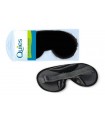No information is available on its latex content.
Patient conditions:
- Avoid previous physical exercise
- Rest for 5 minutes before measurement
- Proper position (avoid isometric muscle activity): seating, straight back and resting on the backrest of the chair and arms supported at heart height, legs not crossed
- Avoid measuring in cases of disconfort, full bladder, etc.
- Quiet and comfortable atmosphere.
Pre-measurement relaxation:
- Reduce anxiety or restlessness as much as possible
- Minimize mental activity: don't talk, don't ask
- Avoid caffeine or tobacco use in the previous 15 minutes and symptoms (e.g. pain) or psychic/emotional agitation
Measurement:
- Select the arm with the highest PA, if any
- Adjust without slack and without compressing
- Remove thick garments, avoid wrapping them so that they compress
- The center of the chamber (or the mark of the cuff) must match the gill artery
- The cuff should be at heart level; but not so the device, which should be well visible to the explorer
- Follow the manufacturer's instructions
- In general, it is necessary to turn on the sphygmomanometer and proceed to the measurement by pressing the button indicated for this purpose
- Wait to finish reading and record it on the appropriate sheet.
It is important to take it correctly to get exact values.
Sit in the right position in a chair and put your arms on the table. If the wrist is not at heart level, a correct value will not be obtained. Relax your shoulders and arm, and take it in a natural posture.
It is important to take at home and write down the obtained values, every day at the same time; so, you can figure out the trend of your pressure. Your doctor will diagnose the results to advise you on your health care.
Because the taking posture and thickness of the blood vessels are different in the socket on the wrist, the value may vary slightly from the intake in the arm.




























